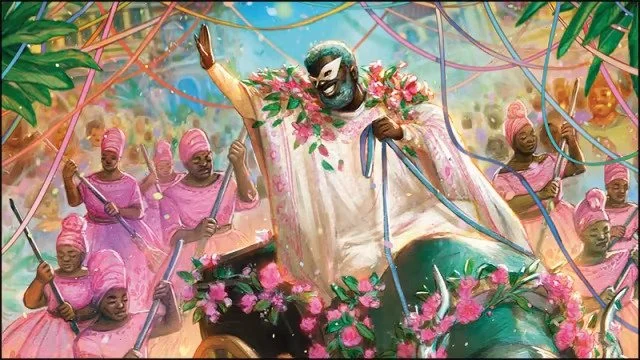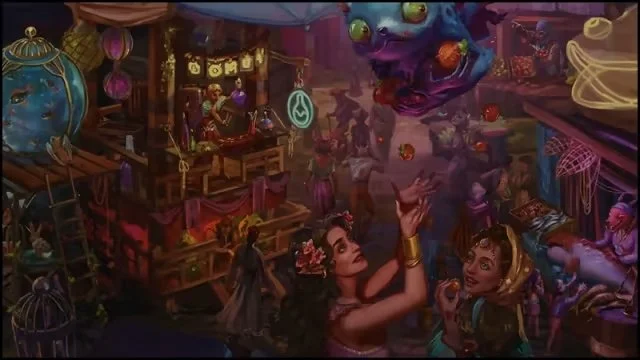Journeys Through the Radiant Citadel: a “rich and varied” collection
Adrianna Burton, Guest Contributor
“There is no guarantee that the light of the Radiant Citadel will be visible to the naked eye on your plane of existence, but know that it is there, whether seen or not.”
Journeys Through the Radiant Citadel is Dungeons & Dragons’ biggest contribution to diversity within 5e, and D&D lore at large, thus far. With sixteen writers of color–a D&D first for an abled, white, and cis male-dominated space–Radiant Citadel has caught even USA Today’s eye. D&D has hit a surge of popularity for a whole lot of reasons–popular culture influences like Stranger Things being high among them. As D&D becomes a hobby for more and more people, I have to ask–who is included in Dungeons & Dragons community, culture, and canon?
In the development and distribution of Radiant Citadel, D&D publisher Wizards of the Coast suggests the answer to my question is everyone. Radiant Citadel’s co-lead designers, Ajit A. George and F. Wesley Schneider, and their writing team have given interviews available on the game’s official page for each module and its creation process in Radiant Citadel. This collection of thirteen journeys, along with the broader Radiant Citadel city itself, creates a much needed space for people of color to find hope and joy in D&D.
Besides reading Radiant Citadel upside down and sideways, I immediately scrambled to put together a Roll20-based campaign with a handful of other tabletop gaming academics. Our party decided to start with “Shadow of the Sun,” a module where “rival factions clash in an angel-ruled city on the brink of rebellion.” We integrated the TTRPG Safety Toolkit into our Roll20 game and got started immediately. One player’s line–a hard limit on content that players don’t want to engage in–was “Nazi tropes,” which means an overarching limit on fascist governments engaging in genocide. For a setting about rival factions and rebellion, I was honestly a little worried. Rebellion is complicated, messy, and never black-and-white. While rebellion and violence is unique and different in every country, I wondered if 5e was brave enough to portray the multitude of perspectives on rebellion, particularly from the perspective and experiences of real-world Iran, which “Shadow of the Sun” takes its mythological and historical inspiration from, as its writer Justice Ramin Arman discusses.
A couple months of biweekly playing later, our hard line is still an occasional concern. Some players feel railroaded into siding with the revolutionaries, while others feel sympathetic towards the angelic rules of Akharin Sangar. This split in perspective was, of course, intentional–war and revolution isn’t one-sided, and neither should our party be. Our party found themselves invited to Akharin Sangar at the request of the local military government, the Brightguard. One party member–whose player is writing a 2.5k-and-counting word fanfiction about their character–is a higher-ranking Brightguard soldier named Zashir Khaleed. The party has so far navigated the tenuous middle ground of investigating the rebels without turning anyone in or taking sides, although the bloodthirsty twins from Yeonido have certainly enacted a lot of violence against them. Radiant Citadel describes Yeonido as “the city of Judgment”' rooted in tradition–tradition against which my players find themselves opposed. Our fourth player character (PC) is from Atagua, a a country of “scattered outposts connected by walkways called the Grassroads,” and our last PC is from Zinda, a tropical country defined by winemaking and “wages of vice.”
As a group, we found the gazetteer questions for characters from each area to be extremely thought-provoking. The gazetteer’s last section is titled “Characters from” each new setting. For each new location, they provide three questions that are useful character creation strategies to immerse players into the country or city’s culture. For Akharin Sangar, Radiant Citadel asks: 1) How have you been affected by the angel Atash’s rule? 2) Do you worship the Sunweaver? 3) Do you behave differently in private than in public? These three are each followed by extra follow-up questions to encourage brainstorming. Each question broaches potential conflict for the characters, as the module’s plot focuses on tension between Atash’s current government rule and rising rebellious factions. For a group of academics with no personal ties to the countries represented by their PC’s place of origin, we all felt motivated and excited to learn more about each culture in the through play and outside of the game. Overall, each module in Radiant Citadel gives space for a fantasy outside of the norm.
The last module in Radiant Citadel is “Orchids of the Invisible Mountain,” inspired by the country of Venezuela. While I’m Central American and not Venezuelan, I cackled at the description of culture in Atagua: “The folk of this land work hard by day, but they mark each noon as the start of the siesta, which offers a much-needed respite from the midday heat.” A midday siesta can be common in many Latine cultures, but to see that as a key descriptor as a funny nod to shared experiences and familiar ties. On almost the flip side, I was intrigued and contemplative when the module suggested that invasion was a present threat–“And some among the Green Doctors whisper that Atagua might yet face an invasion by those terrors”–a striking parallel to destruction caused by intervention during the Cold War across what are now referred to as Third World countries. That is all to say that Radiant Citadel provides a nuanced experience of these fantasy worlds, inspired by reality. I was surprised, impressed, and excited for the future of D&D (only to be floored by the announcement of One D&D!).
The concept of the floating, ethereal connective tissue of the planes, known as the Radiant Citadel, was what we all found real to our own lived experiences with D&D, in a way that we hadn’t experienced with other D&D content, like Van Richten’s Guide to Ravenloft or Strixhaven: A Curriculum of Chaos. As Ajit George described in an interview with Dragon Magazine:
It’s not unusual for people these days to feel tense and under siege in their lives. I wanted to give them a fantasy space that felt protected and safe. Sure, they can go on any of the hundreds of adventures that will be spawned out of this place and bad things might happen. But they can always return to the Radiant Citadel and find shelter, food, healing, and the respite they need to regroup and rebuild, before heading out on a new adventure.
As embodied by the titular Radiant Citadel, there is hope that D&D is, or can be, a space for inclusion and safety; for a wide array of stories to explore and tell. All things considered, Journeys Through the Radiant Citadel is one of the most creative fantasy settings I have ever had the pleasure to play.
Part of the Games of Color Column: The column aims to foreground, highlight, and engage with BIPOC games, gamers, scholars, designers, and artists. Given that games code and encode, render and represent social, cultural, political, even pedagogical norms, we hope to address the problems and possibilities of this medium we enjoy. Once or twice a month, we will think, talk, and play through the ways that games and gaming communities must reckon with race, difference, diversity, and equity. For more information or to contribute, contact Contributing Editor Edmond Chang.





